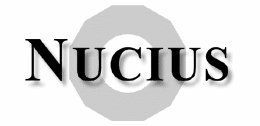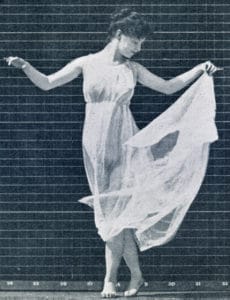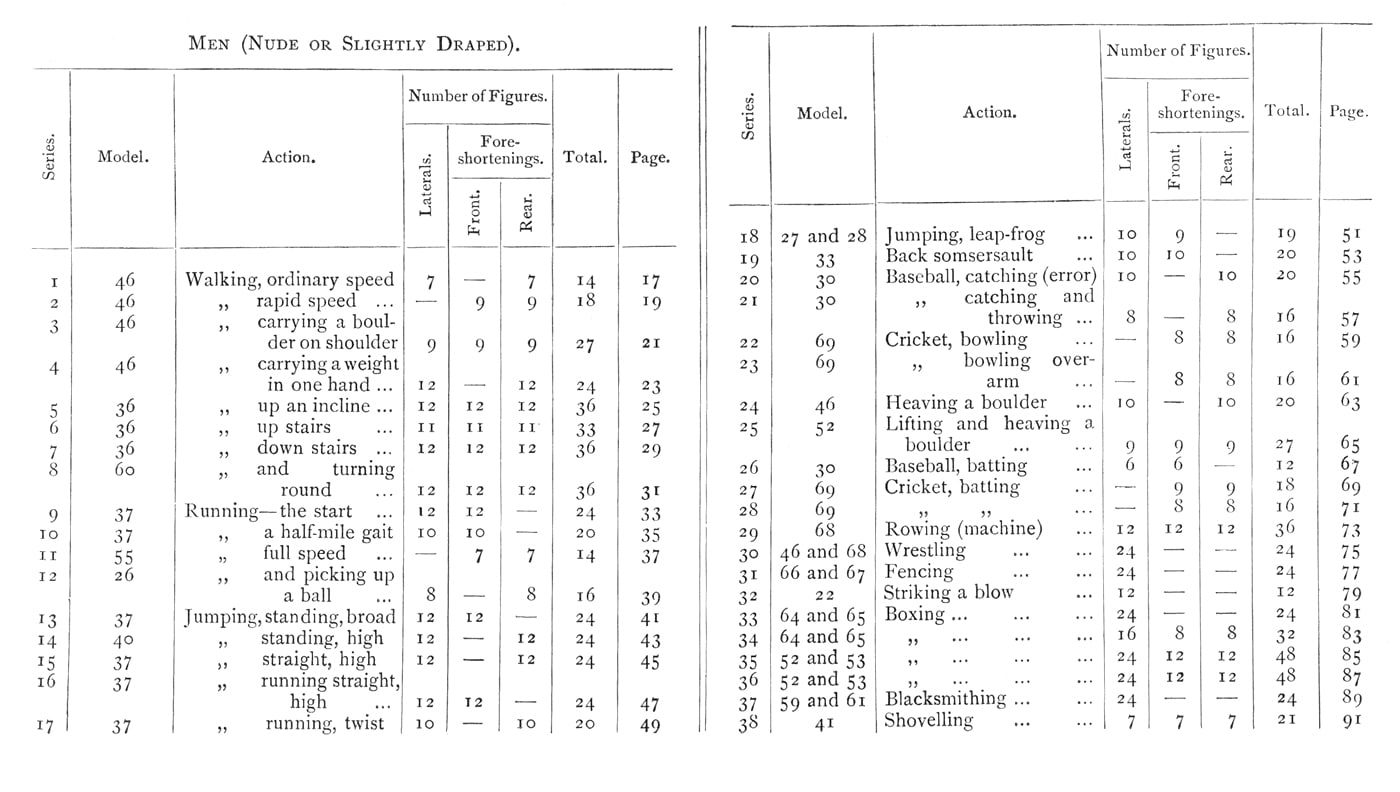Es folgen die Einleitung und das Abbildungsverzeichnis, wie sie in Muybridges Werk „The Human Figure in Motion“ zum Abdruck gekommen sind:
Introductory
In the „Transactions of the Royal Institution of Great Britain,“ of date March 13, 1882, is printed an epitome of a lecture, given by the author of the present work, on the Science of Animal Locomotion in its relation to Design in Art, which is thus alluded to in an article by the late George A. Sala, published in the Illustrated London News, on the 18th of the same month –
On Monday last, in the theatre of the Royal Institution, a select and representative audience assembled to witness a series of most interesting demonstrations of animal locomotion, given by Mr. Muybridge … who exhibited a large number of photographs [illustrating consecutive phases in the motion] of the horse, walking, ambling, galloping, and leaping … By the aid of an astonishing apparatus called a zoöpraxiscope, which the lecturer described as an improvement on the old zoetrope … the animals suddenly became mobile and beautiful, and walked, cantered, ambled, galloped, and leaped over hurdles in the field of vision in a perfectly natural and life-like manner. …
After the horses, dogs, oxen, wild, bulls, and deer, were shown under analogous conditions of varied movement, and finally man appeared (in instantaneous photography) on the screen, and walked, ran, leaped and turned back-somersaults to admiration. …
On the following Thursday Mr. Muybridge repeated his demonstrations at the Royal Academy of Arts.
The transparent photographs used during these lectures were some of the results of an investigation commenced by the author at Sacramento, California, in May, 1872, and continued, with numerous periods of intermission, at Palo Alto, in the same State, until 1879.
The zoöpraxiscope was devised by the author, on the principle initiated in the early part of the nineteenth century by the Belgian physicist Plateau – for the purpose of demonstrating the persistency of vision – and is briefly described in an essay by the late Professor Richard A. Proctor, „Photographs of a Galloping Horse,“ printed in the Gentleman’s Magazine for December, 1881. A detailed description of the apparatus is given in a recent work by the author, „Animals in Motion“ (Chapman & Hall, Limited, 1898). It will, therefore, be unnecessary in this place, to repeat what is there said in regard to its construction. It may, however, as a matter of record, be admissible to say that, as photographic analyses of changes incidental to motion of any kind commenced with this investigation by the author, so was the zoöpraxiscope the first instrument ever constructed or devised for demonstrating, by synthetical reconstruction, movements originally photographed from life, and for many years it was the only apparatus in use for that purpose. In the progress of physical science and mechanical construction it has, as might naturally be supposed, had to relinquish to its younger rivals its former unique position; but it was not until 1893, or more than thirteen years after it was first used, that any improvement in its construction or in its effects on the screen were made public. The improvements in the modern instruments are due to the invention of celluloid, as a substitute for glass, for receiving and exhibiting the photographic images.
At the present day, when the many and important chemical discoveries and new appliances enable any youth of ordinary intelligence, by the expenditure of a few shillings and a little attention to printed instructions, to become an amateur photographer, it is not easy to realize the difficulties which had to be surmounted – even so late as twenty years ago – in the production of a satisfactory photograph of a rapidly moving object, which, the writer of the essay in the Gentleman’s Magazine before mentioned, states he „was assured by one of the ablest English photographers was absolutely outside the bounds of possibility;“ it may not be out of place therefore, to reprint a few paragraphs on the subject, written by the editor of Knowledge (London), which appeared in that journal April 14, 1882.
„A few years ago the news of the successful photographing of a galloping horse was received with incredulity. … That a horse rushing along at the rate of a mile in one and two-thirds of a minute [more than seventeen yards in a second], and moving its limbs forward in part of each stride with nearly twice that velocity, should be seized by photographic art so as to show every limb well and clearly delineated, would have seemed wonderful indeed to the early professors of that art. Still more amazing is it to find ten or twelve distinct pictures taken during a single stride, the comparison of which, inter se, enable the most rapid of all equine movements to be analyzed as though the horse could be made to go all through all the motions of the swiftest gallop at a funeral pace. Then, by combining them in a much-improved kind of zoetrope – the zoöpraxiscope – the horse can be made to go through the action as perfectly as though he were actually galloping before the eyes of the audience. … This has been done for the horse, and other animals, athletes, gymnasts, and even for birds.
Not only the characteristic movements of the different actions, but even those slight and scarce definable peculiarities which distinguish the movements of one athlete from another in performing the same feat, of one horse from another in moving at the same gait, and so forth, are perfectly recognizable in the combination of pictures which, separately seen, simply startle us by the new light which they throw on the real nature of these rapid movements.
In comfirmation of those „slight and scarcely definable peculiarities“ recognized by the editor of Knowledge in the synthetic realizations of the zoöpraxiscope, the author will not readily forget the complete refutation of an assertion made by him the first time the apparatus was put into practical operation. The anecdote may not be without interest, especially to the constructors of the many different instruments which, at the present day, have taken the place of their prototype.
Upon the completion of a series of twenty-four consecutive phases, illustrating a single stride of a noted horse from the stables of Governor (afterwards Senator) Stanford, that gentleman, one evening in the autumn of 1879, invited a few friends to witness, by projection with the oxy-hydrogen light and the zoöpraxiscope, the primitive synthetical reproduction of an animal’s movement. „There, Governor,“ said the author, as he put the apparatus in motion, „you have a representation of Hawthorn galloping at a one forty-two gait,“ that horse being one of several with which he had experimented. After a few seconds‘ attention, his host exclaimed,“ I think you must make a mistake in the name of the animal; that is certainly not the gait of Hawthorn, but that of Anderson,“ another horse on the Palo Alto ranch. The author disputed this correction, and reasserted the accuracy of the entry in his record-book. The Governor was equally positive of its error. Upon reference, the next day, to the trainer, the author was informed, very much to his surprise, that the horse sent to him for that particular experiment (without the knowledge of its owner), was Anderson; and at the moment he felt more disappointed at the inaccuracy of his registry than gratified with the perfect manner in which the zoöpraxiscope had performed its duties.
In 1878 the author published, under the general title of „The Horse in Motion,“ some of the results of his labours in a few sheets of photographs, each one of which illustrated several consecutive phases of a horse while trotting, galloping, and so forth, which were duly deposited, the same year, in the Library of Congress at Washington. Some of these photographs quickly found their way to various parts of the world, and were commented upon by numerous journals of the day. References to a few early reviews of these demonstrations may be found in the Appendix.
The publications of 1878 were followed, in 1881, by a quarto volume of some two hundred pages of photographs, illustrating various movements by horses, dogs, and other animals, and feats of the gymnasium and the field by some Californian athletes.
The favour with which these demonstrations were received convinced the author that a more comprehensive investigation, carried out in a more exating and systematic manner than was at that time possible at Palo Alto, and with the advantages offered by the then newly discovered dry-plate process, would result in throwing much additional light on the hitherto little known but important problem of animal movements. This new enterprise – if conducted on the contemplated scale – promised to involve such a large expenditure, that some little time elapsed before the necessary arrangements for its execution could be made.
The author was, however, fortunate enough to obtain the co-operation of the University of Pennsylvania, then under the able administration of the late Dr. William Pepper, and was instructed by the trustees of that institution to continue his researches under its auspices. The work was recommenced in the summer of 1884, and completed in the autumn of the following year.
The system adopted and the apparatus employed differed in no material respect from that used in California, which, having been fully described in „Animals in Motion,“ it will here be only necessary to say, that by means of three batteries of cameras electrically operated by a motor-clock, twenty-four successive photographic exposures could be made in a quarter of a second of time; and twelve successive exposures, simultaneously made from each of three different points of view could be completed in the one-fifth of a second. The time-intervals between each consecutive exposure of a series were recorded by a chronograph, in one-thousandths of a second, and are, with a few exceptions, reprinted under each series of illustrations.
The results of this investigation – consisting of 781 photo-mezzotint engravings, with examples of more than twenty-thousand acts of motion by animals, birds, and human beings – were, in 1887, published in eleven folio volumes, under the title of „Animal Locomotion.“ Copies of the work were secured by the principal libraries and institutions of science and of art in Europe and America, where they may be consulted by those interested in the subject. Selections of the engravings were also issued in portfolios, and some hundreds of such selections were subscribed for their individual use by artists, scientists, and others on both sides of the Atlantic. In the Appendix may be seen a few facsimile autographs, selected – not without difficulty – from the subscription list of the author, who avails himself of this opportunity to express his sincere thanks to the many distinguished men who thus endorsed the value of his labours.
It being so universally recognized that a study of the precise functions of the limbs, whether of man or of the lower animals, as made known by photography, is of great importance to the physiologist, and to the natural scientist generally; and that a knowledge of the successive appearances which those limbs assume while executing any specific movement is of absolute necessity to the artist, that he may obtain a correct impression of that movement as a whole, and be thus enabled to give a satisfactory and truthful interpretation of it; – it has been decided to republish a number of the most generally useful seriates in a more convenient and popular manner than was adopted in the publication of the original work, in the hope of thus more widely disseminating a knowledge of the facts revealed by the author’s researches.
With this object in view, a number of movements of horses and other quadrupeds and birds have, as previously stated, been already republished with the title of „Animals in Motion.“ The present volume, as its title implies, is devoted exclusively to the human figure.
With regard to the models, the greater number of men were students or graduates of the University of Pennsylvania, each one of whom had a well-earned record in the particular feat selected for illustration. Model 46 was the professor of physical culture; 37, the champion runner, and a good jumper; 69, the best all-round cricketer, and 30 was equally noted in the game of base-ball. 52, 64, 65, 66, and 67 were instructors at the Fencing and Sparring Club; and 22 was a well-known pugilist. The mechanics were experts in their particular trades, and the labourers were accustomed to the work they are represented doing.
Of the women, 5, 7, 8, 9, 10, and 13 were artists‘ models, and 12 was a première danseuse from one of the Philadelphian theatres.
In addition to the engravings which illustrate successive phases of a continuous or of a completed action, it was thought desirable, in consideration of the small dimensions of the figures, to select some of the phases and re-engrave them the same size as that in which they were originally published. For this selection, and for the omission of many phases necessary to properly illustrate the continuity of an action, the author disclaims all responsibility.
In his examination of the contents of this volume the critical observer will do well to remember that the negatives from which the photo-mezzotints are copied were made more than fifteen years ago; they are reproduced without the slightest attempt being made to improve them; and are presented with all their faults, precisely as taken in the camera.
It cannot be too forcibly impressed on the mind of the student, that the photographed phases of motion in either of the volumes, are not intended for use as a substitute for personal observation. Their value consists, not as individual photographs made at particular instants in the performance of some muscular act – which any one with a hand camera could do equally as well – but as seriates of phases, demonstrating the various changes which take place in the disposition of the limbs and body during the evolution of some act of motion from its inception to its completion. Studied in this manner, the author is not without hope that the artist will realize a just appreciation of the movement itself, and be enabled to give expression to it in an acceptable and at the same time truthful manner.
[Eadweard Muybridge: The Human Figure in Motion. An Electro=Photographic Investigation of Consecutive Phases of Muscular Actions. Third impression. London, Chapman & Hall, LD. 1907. pp. 5-9.]
Catalogue of illustrations
The consecutive phases of nearly all the serial illustrations of movement were synchronously photographed from each of two or from three points of view. Wherever convenient, the foreshortened phases are placed immediately under the corresponding phases of the lateral series. In some of the seriates, two lines of figures are required for the laterals, and one line only for the foreshortenings; in this event the corresponding phases can be readily ascertained by counting the figures.
In all the seriates the sequence of phases is indicated by an arrow.
The classification of the figures into laterals, front-foreshortenings, and rear-foreshortenings, is, in some of the seriates, purely arbitrary. These designations are usually given to the first phase from each of the respective points of view.
The intervals of time between the successive phases – when the chronograph was used – are recorded, under each series, in thousandths of a second. If it is required to ascertain the time in which the complete movement, or any portion of a movement, was effected, it will be merely necessary to multiply the number of thousandths of a second by the number of intervals. For nearly all purposes, however, the calculation of intervals in hundredths, or perhaps even tenths, of a second may be found sufficiently accurate.
As a general rule, the points of view of each lateral series were at an elevation of about one-half the height of the model while standing on the ground. In seriates 1 and 4, the lateral points of view were on a level with the platform on which the model was walking, and so also with the larger figures of the same action as series 1. The points of view of the foreshortened series were – when at an angle of 90° to the laterals – of varying heights of a vertical line; either ascending or descending 3 inches for each successive exposure. The points of view from other angles were usually on one horizontal line, and about the level of the lateral serials.
The lines on the background were 5 centimetres, or about 2 inches, apart, with broader lines 50 centimetres, or about 20 inches, apart. The usual distance of the model from the background was, for the laterals, about 75 centimetres (30 inches); the distance of the model from the lateral camera usually approximated 15 metres, or nearly 50 feet.
[Eadweard Muybridge: The Human Figure in Motion. An Electro=Photographic Investigation of Consecutive Phases of Muscular Actions. Third impression. London 1907. pp. 12-15.]







